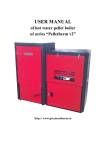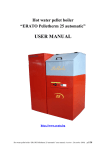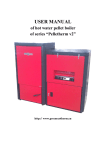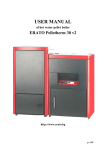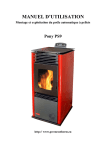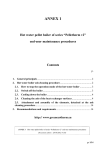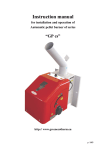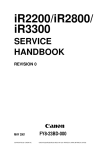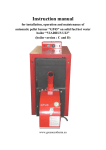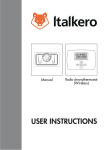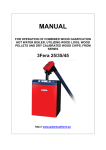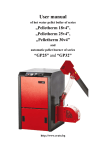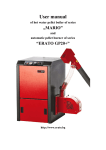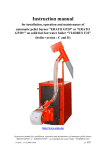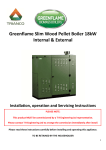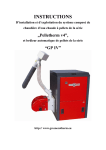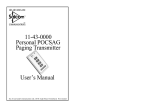Download USER MANUAL - GreenEcoTherm
Transcript
USER MANUAL of automatic hot air pellet stove of series Pony http:// www.greenecotherm.eu Producer Address Phone Fax e-mail home page ZMM Haskovo Plc. Bulgaria, Haskovo 6300, “Saedinenie” 67 blvd. +359 800 15 145 +359 38 603070 [email protected] www.greenecotherm.eu Thank You for buying automatic hot air pellet stove of series „Pony”. This manual will help You to use and maintain the unit properly. NOTE : the model “Pony PS9” is designed mainly for single room heating purposes, while the model “Pony PS9D” is equipped with additional hat air channel for supplying another room with hot air, prepared by the stove’s heat exchanger. ATTENTION! IN INTEREST OF YOUR PERSONAL SECURITY IT IS OBLIGATORY TO READ THOROUGHLY AND CAREFULLY THIS INSTRUCTION MANUAL BEFORE PROCEEDING WITH ANY ACTIONS WITH THE STOVE – MOUNTING, CONNECTING, ETC. IN CASE THAT REQUIREMENTS, DEPICTED IN THIS MANUAL ARE NOT SATISFIED, FAILURES OF THE UNIT COULD BE EXPECTED, OR EVEN FATAL CONSEQUENCES, FOR WHICH THE STOVE PRODUCER COMPANY DOES NOT TAKE RESPONSIBILITY. User manual for automatic hot air pellet stove of series “Pony” (model “Pony PS9” and “Pony PS9D”); (document version: 28.02.2012 10:40) Page. 2/61 CONTENTS Page 1. Description and advantages of automatic hot air pellet stove of series “Pony”. ................................................................................................................. 5 2. Technical data of automatic hot air pellet stove of series “Pony”........ 7 Table 2.1 Thermal and technical data for hot air stove of series “Pony”, utilizing wood pellets......................................................................................... 8 Table 2.2. Operating parameters of the heated air, supplied thought the ducts to another room – valid for model “Pony PS9D” only, at totally closed air distribution control flap...................................................................................... 8 Table 2.3 Dimensions and technical data of hot air stove of series “Pony”, utilizing wood pellets......................................................................................... 9 Table 2.4 Recommended solid fuel properties – wood pellets ............................ 9 Table 2.5 ENplus - European standard for wood pellets; ............................... 10 3. Description of the construction of hot air automated pellet stove “Pony PS9”......................................................................................................... 11 4. Installation process. ................................................................................ 21 4.1. Norms and recommendations :.............................................................. 21 4.2. Norms and recommendations ................................................................ 21 4.3. Installation process of the stove. ............................................................ 22 4.4. Appliance positioning in order to achieve comfortable maintenance.... ................................................................................................................... 23 4.5. Connecting the stove to a chimney ........................................................ 25 4.6. Connection of the hot air pellet stove , model “Pony PS9D” with hot air duct for heating another room in a dwelling ............................................ 29 5. Entering the appliance in service. ......................................................... 31 5.1. Basic fuel requirements....................................................................... 31 5.2. Starting hot air pellet stove of series “Pony” procedure. ................ 32 5.2.1. Interface control board of hot air pellet stove of series “Pony” ..................................................................................................... 33 5.2.2. panel. Description of the function of the buttons of the interface ..................................................................................................... 34 5.2.3. Power supply of the stove ......................................................... 36 5.2.4. Turning ON the appliance........................................................ 36 5.2.5. Set up of the stoves operating parameters .............................. 38 Page. 3/61 5.2.6. Set up of the stove according to the thermal power needed.. 42 5.2.8. Adjustment of the operating parameters of the hot air, supplied to a neighboring room – valid for model “Pony PS9D” only. ....... 43 5.2.9. 5.3. Nominal operating mode of the stove...................................... 43 Adjustment of the thermal capacity of the stove.............................. 44 5.3.1. Decreasing the thermal capacity of the stove ......................... 44 5.3.2. Decreasing the thermal capacity of the stove ......................... 44 5.3.3. Adjustment of the thermal capacity of the hot air, supplied to the neighboring room – valid for model “Ponu PS9D” only......................... 45 5.4. Stopping the operation of the stove.................................................... 45 5.5. Cleaning the stove................................................................................ 45 5.6. Turning OFF the stove........................................................................ 49 Emergency stop of the stove................................................................. 49 5.7. Showing and teaching the end user about the maintenance and adjustment procedures. ................................................................................. 50 5.8. Safety and unexpected risks ............................................................... 50 5.9. Operation faults and their repairing from the end user.................. 52 5.10. Alarm messages, shown on the display of the stove ......................... 55 Table 5.8. Alarm messages, shown on the display of the stove ..................... 55 5.11. Operation faults and their repairing from the service personal ONLY .............................................................................................................. 56 5.12.Hot air pellet stove of series „ Pony” warranty form completion. ... 59 5.13. Actions, after the unit is not in exploitation anymore...................... 59 6. Electrical scheme of the apliance........................................................... 60 WARRANTY CONDITIONS .......................................................................... 61 Page. 4/61 1. Description and advantages of automatic hot air pellet stove of series “Pony”. The unit of series “Pony PS9” is steel-plate hot air pellet stove, which uses solid biomass fuel in shape of pellets. The stove is designed for local heating of domestic and office spaces. The stove utilizes wood pellets, as well as other type/shape of biomass; the resulting heat energy from thermo-chemical conversion (i.e. combustion process) is transmitted from the heat-exchanging surfaces to the surrounding air, both by convection as well as thermal radiation. The model “Pony PS9D” is equipped with additional hot air duct for heating more that a single room. The complete set of the pellet stove consists of: Automatic hot air pellet stove– 1 ct; Battery – Toshiba 23A, 12v, V23GA – 1 ct; Remote control - 1 ct; Plastic heels M10 X 43 - 4 ct; Handle - 1 ct; PC power supply cable AC 220V - 1 ct; Users guide for automatic hot air pellet stove of series “Pony” – 1 ct; The unit could utilize following types of fuel: Wood pellets, having diameter 6 mm, covering the requirements of class ENplus-A1 of standard EN 14961-2:2010; Other solid biomass based pellets, but confirmation for these fuels utilization need testing and approval by stove’s producer company laboratory; The unit is equipped with: Steel plates welded heat exchanger for heating-up the surrounding air; Flue gas fan; Fan for forced convection and heating-up of the surrounding air; Daily fuel hopper with capacity of about 19 kg; Programmable operating module, which controls the functions of the unit and is adjustable to the specific needs of the client; Ash container with capacity of 0.5 kg; Page. 5/61 The model “Pony PS9D” only : the unit is designed with additional air flow control system, allowing hot air distribution control and hot air supply duct fir heating another room; The unit is supplied with: Automatic fuel ignition system; Automatic fuel feeding auger system; Remote control; Unit’s advantages: The hot air stove gives you an incredible feel of warmth and comfort due to a controlled and highly efficient combustion process; The model “Pony PS9D” is redesigned in order to allow simultaneous hot air supply to another room of the dwelling; The hot air stove is designed to utilize solid biomass fuel, making it environmentally friendly, CO2 neutral and does not contribute to the global warming process – result of fossil fuel utilization; The specific price of the heat energy, delivered by solid biomass utilization is less dependent on the world fuel market trends and practically the heat energy price is competitive to the conventional energy sources; The stove is automatic and the thermal comfort achieved is close to that, originating from exploitation of fully automatic heaters, (for example running on liquid or gas fuel, as well as electric heaters). The stove is equipped with integrated programmable room thermostat (daily, weekly and weekend programs); The unit is equipped with automatic fuel ignition system and performs burner’s ash cleaning procedure, controlled by the electronic module; Remote control of the operating mode of the stove; The stove utilizes wood pellets, covering the requirements of class ENplus-A1 of standard ENplus, or other standards as ONORM M7135, DIN 51731 и DINPlus; High efficiency; Low pollutant contents in the flue gases; Automatic fuel feeding system, transported from the built-in “daily” hopper to the burner; Simplified maintenance and service procedures; Minimized running costs; Page. 6/61 2. Technical data of automatic hot air pellet stove of series “Pony” Thermal and technical data for hot air stove of series “Pony”, utilizing wood pellets are given in Table 2.1; Operating parameters of the hot air, heated up by pellet stove “Pony PS9D” are given in Table 2.2; Dimensions and technical data for hot air pellet stove of series “Pony” are given in Table 2.3; Recommended solid fuel properties – wood pellets, are given in Table 2.4; The European standard for wood pellets properties is given in Table 2.5; Page. 7/61 Parameter Nominal thermal capacity Thermal capacity operation range Utilized solid fuel Utilized pellets, complying ENplus Wood pellets fuel consumption rate at nominal thermal capacity Dimension Value kW 9 kW 3.5 – 9 Wood pellets diameter d=6mm ENplus – A1 Fresh air flow rate, required for effective combustion process Averaged wood pellets consumption rate Average refueling cycle Thermal efficiency at nominal capacity Air excess ratio Flue gases temperature at nominal thermal capacity kg/h 2.1 kg/h 16 - 18 m3/h kg/h h ℅ λ 14 - 16 1.2 up to 20 up to 90 1.6 – 1.9 ºC 160 – 200 ash The quantity depends on the ash contents in the raw fuel, as well as operating conditions Solid fuel residue Table 2.1 Thermal and technical data for hot air stove of series “Pony”, utilizing wood pellets. Parameter Temperature at nominal thermal capacity Temperature at minimal thermal capacity Heating capacity of the hot air at nominal operating mode Heating capacity of the hot air at minimal operating mode Dimension Value 160 - 190 ºC 115 - 130 4.0 - 4.4 kW 1.8 - 2.0 Table 2.2. Operating parameters of the heated air, supplied thought the ducts to another room – valid for model “Pony PS9D” only, at totally closed air distribution control flap. NOTE : the data, shown in above table should be considered tentative, as in practice the temperature of the heated air, as well as the air flow rate are strong function of the ambient air and mainly the hydraulic loses in the hot air duct, Page. 8/61 which conducts the hot air to another room (mainly the length as well as the number and configuration of the curves). Parameter Model kg Value PS9 PS9D 91 105 29 19 kg (wood pellets mm - 470x612x1083 3 ºC 20 ºC 14 Pa mm 4 - 10 35 Flue gases duct mm 80 Hot air duct Electrical supply mm - Electrical power VA --80 50Hz; 230V <100 < 350 (at ignition process) IP20 Weight Fuel hopper capacity Overall dimension of the unit (WxDxH) Class (according to EN 303-5) Recommended air temperature in the heated space Minimum air temperature in the heated space Draught Fresh air channel Connections Environment protection index Dimension kg dm³ - d=6mm) Table 2.3 Dimensions and technical data of hot air stove of series “Pony”, utilizing wood pellets. The recommended fuel for hot air stove of series “Pony”, utilizing pellets is: wood pellets with specific size – diameter 6 mm. Main properties of the fuel are given in the next table. Parameter Pellet’s characteristic size Pellet’s characteristic length Recommended fuel net calorific value (low heating value) Wood pellet class according to ENplus Ash content Moisture content Dimension Value mm 6 mm Max 30 MJ/kg >17.2 kWh/kg >4.7 ENplus-A1 % See Table 2.4. % Max. 8 – 10% Table 2.4 Recommended solid fuel properties – wood pellets Page. 9/61 The European wood pellets standard EN 14961-2:2010 defines wood pellets certificate ENplus for pellets, utilized in boilers, stoves and appliances for domestic heating systems. The certificate EN-B is applied for pellets, utilized in industrial boilers. In principal the ENplus standard defines two quality classes: А1 и А2. The class А1 is highly restricted, considering the ash content. The class А2 the limit of the ash content of the wood pellets is higher – up to 1.5%. For industrial boilers the certificate EN-B is applicable, which defines fewer restrictions on the pellets quality. Parameter Diameter Length Bulk density Low calorific value Moisture content Dust Mechanical durability Ash content Ash melting point temperature Cl S N Cu Cr As Cd Hg Pb Ni Zn Dimension mm mm kg/m³ MJ/kg % % % % 2) °C % 2) % 2) % 2) mg/kg 2) mg/kg 2) mg/kg 2) mg/kg 2) mg/kg 2) mg/kg 2) mg/kg 2) mg/kg 2) ENplus-A1 ENplus-A2 6 (± 1) 6 (± 1) 1) 3,15 ≤ L ≤ 40 3,15 ≤ L ≤ 40 1) ≥ 600 ≥ 600 ≥ 16.5 ≥ 16.5 ≤ 10 ≤ 10 3) ≤1 ≤ 1 3) ≥ 97.5 4) ≥ 97.5 4) ≤ 0,7 ≤ 1.5 ≥ 1200 ≥ 1100 ≤ 0.02 ≤ 0.03 ≤ 0.05 ≤ 0.05 ≤ 0.3 ≤ 0.5 ≤ 10 ≤ 10 ≤ 10 ≤ 10 ≤1 ≤1 ≤ 0.5 ≤ 0.5 ≤ 0.1 ≤ 0.1 ≤ 10 ≤ 10 ≤ 10 ≤ 10 ≤ 100 ≤ 100 1) not more that 1% of the wood pellets should be with length of 40 mm, the maximal pellet length is 45 mm ; 2) determined on dry mass; 3) the particles are <3.15 mm, fine particles, before fuel delivery; 4) in case the test measurements are performed with Lignotester, than the limit value is ≥ 97.7% m.w.; Table 2.5 ENplus - European standard for wood pellets; Page. 10/61 3. Description of the construction of hot air automated pellet stove “Pony PS9” The heat exchanger of the stove complies with the acting requirements for such kind of units, defined in operating norm: EN 14785:2006 – „Heating units for dwellings, utilizing wood pellets. Terminology, requirements, testing and marking”. The unit consists of: Main part of the unit is heat exchanger. In the combustion chamber of this exchanger is mounted specialized grate burner, designed for horizontal fuel feeding; The heat exchanger is welded construction of carbon steel plates. The lower part of the exchanger is designed as combustion chamber. The burner is mounted in this chamber and under is the ash container. Combustion chamber: It is designed to provide conditions for optimal burning process and helps for complete combustion of the fuel. The chamber is closed by a door with heat-resistant (ceramic) glass, giving the possibility to see the combustion process and also provides direct heat radiation to the surrounding objects. Stainless steel burner, mounted in the combustion chamber of the heat exchanger; Ash container, positioned in the lower part of the combustion chamber, below the burner; Fuel hopper is mounted right behind of the stoves’s burning chamber. In the hopper (in the center and inclined) is mounted a fuel transport auger; Fresh air for burning is provided by a pipe. The air for burning needs to be with room temperature. Do not connect the pipe directly to the outside of the building; Flue gases exit duct is positioned in the lower rear side of the unit (after the flue gases fan, concerning the flue gases flow direction), utilized for forced flue gases extraction; Hot air duct, which allows the heated ambient air to be convected to another room – this is valid for model “Pony PS9D” only. The size of the duct is shown in Table 2.2. The hot air distribution is controlled by a level drive flap, installed in the front upper section on the unit; Control unit it is placed in a cold zone of the stove and provides save function of the appliance. The control is equipped with a lithium battery, Page. 11/61 which has live time of 5 years – it is used to memorize the settings of the control module in cases of interrupted main power supply. In order to maintain safe function the stove is supplied with a pressure switch for monitoring the functionality of the chimney. In cases of malfunction of the chimney, the pressure switch stops the stove immediately, preventing damages to the appliance and emergency situations. Also the stove is monitoring the flue gases temperature. In cases of increased temperatures, the controller of the stove goes in minimum power, or in case of excessive values, it shuts down the unit; Interface panel is used for set up of the control unit. And to monitor the work parameters and massages; The heat exchanger, fuel hopper and other modules of the stove are covered with decorative covers , powder painted in different colors; Page. 12/61 Interface panel of the control module of the stove Fuel hopper lid Decorative guiding grill for the hot air Door with fire-resistant glass Handle Cover of the ash container Figure 3.1. External view and description of the main modules of hot air stove of series “Pony”; The characteristic dimensions of the automatic hot air pellet stove of series “Pony” are shown on the Figures 3.2 – 3.5. Page. 13/61 Figure 3.2. Front side view of automatic hot air pellet stove of series “Pony”; Page. 14/61 Fresh air for combustion inlet Exhaust gases outflow duct Figure 3.3. Back side view of automatic hot air pellet stove , model “Pony PS9” Page. 15/61 Fresh air for combustion inlet Hot air outflow duct Exhaust gases outflow duct Figure 3.4. Back side view of automatic hot air pellet stove, model “Pony PS9D” Page. 16/61 Figure 3.5. View of automatic hot air pellet stove of series “Pony” – top side view and left side view; Page. 17/61 Main modules/elements of hot air stove , model “Pony PS9” are given in figure 3.6. Interface panel of the control module of the stove Fuel hopper Fuel transport auger Stainless-steel burner Fuel transport auger motor Hot air fan (forced convection fan) Pipe for fresh air Flue-gas duct Flue gas fan Guiding plate – back of the combustion chamber Ash container Combustion chamber door Figure 3.6. Cross section view and description of the main modules/elements of hot air stove, model “Pony PS9”. Page. 18/61 Interface panel of the control module of the stove Fuel hopper Fuel transport auger Stainless-steel burner Hot air duct (for heating another room) Fuel transport auger Hot air fan Pipe for fresh air Flue-gas duct Guiding plate – back of the combustion chamber Ash container Flue-gas fan Combustion chamber door Figure 3.7. Cross section view and description of the main modules/elements of hot air stove, model “Pony PS9D”; Page. 19/61 The lever for air distribution flap control flap is pushed to the unit Figure 3.8. Side view of the lever for controlling air distribution flap of hot air pellet stove , model “Pony PS9D” . In the given position of the lever (the lever is pushed to the grill) the air flap is closed and to another room the hot air flow rate is minimized; The lever for air distribution flap control flap is pulled out from the unit Figure 3.9. Side view of the lever for controlling air distribution flap of hot air pellet stove , model “Pony PS9D” . In the given position of the lever (the lever is pulled from the grill) the air flap is opened and to another room the hot air flow rate is maximized; NOTE : the heat by the stove air is force convected by a centrifugal fan, which is installed section on the basis of the heat exchanger. So in case of change of the position of the lever for controlling the position of the air distribution flap, the room, where the stove is installed, continues to receive heat energy, mainly by radiation and natural convection; Page. 20/61 4. Installation process. 4.1. Norms and recommendations : In order to meet the safety requirements is necessary to meet the following: At least two people are needed to unpack, move and install the pellet stove. Be careful not to damage the covers of the stove or the stove itself. During transportation you need to take in count the information provided on the package; The moving and placing of the stove needs to be done with proper equipment, following the safety requirements. If lifting equipment is used (cranes, forklifts), do not let anybody to stay close to them; In case of using ropes during transportation, take in count their strength and condition; During transportation keep the stove as straight as possible; do not tilt it too much; During unpacking of the stove be careful not to damage the side covers of the stove or the stove itself; After unpacking, take out of the burning chamber all the accessories (if there are any). Also take out all elements used for safe transportation of the stove (pasteboard, cardboard, plastic); ATTENTION: Keep all packing materials out of reach of children. Throw them away in the designated for that purpose places. 4.2. Norms and recommendations Basic requirements during installation of hot air stove of series “Pony”. The room, dedicated to install the stove, should be supplied with fresh air supply duct, necessary for optimal combustion process as well as room ventilation. Place the stove where it will be easily checked, maintained or repaired. PROHIBITED is installing the stove in bedrooms, bathrooms and rooms in which is installed other heat source without a vent (open fire place for instance). Page. 21/61 For model “Pony PS9D” – the room, which will be supplied with hot air for heating, should be connected with the room, where the stove is installed, with the so called return flow duct. It is highly recommended the total length of the hot air flow duct not to exceed 3 meters, in order to sustain optimal air flow conditions. The material of the hot air flow duct, however, is important – it should be fire-proof (for example made of aluminum or carbon steel) and the pipe could be straight-surfaced or corrugated. In order to obtain optimal operation of the heating system, it is highly recommended to prepare a project by a specialized company for the heating systems with all the local details considered; Installation and service procedures should be performed by authorized qualified and certified personal ONLY; The stove needs to be installed on a floor with required strength and fireresistance. In case of not meeting these requirements you need to choose other place for installing the stove or to take the necessary actions in order to improve the place for installation in order to meet the requirements. Most often the stove is installed on fire-proved floors with size larger than the stove itself so safety operation is ensured and possibility of fire is taken to the minimum and also provides easy access for cleaning and maintenance. The minimum size of the fire-proved floor needs to be 150mm from the sides of the stove and at least 300mm in front of the unit. In case of using a metal sheet for meeting above mentioned safety requirements it needs to be at least 2mm thick sheet of metal; It is strongly recommended any flammable objects (wood beams, furniture, curtains and flammable liquids) to be placed on distance at least 1 (one) meter from the zone of intensive heat radiation. In cases that such objects are near to the stove, you need to protect them with a layer of fireresistant insulating material. If the floor is made of flammable material (wood) it is necessary in front of the stove to be placed protective sheet of metal with size 300mm minimum; Before entering the stove in service you need to check the draught of the chimney and to ensure that the stove is properly connected to the chimney; Maintenance procedures of the stove should be performed by trained adult persons, which have read and understood the user manual of the unit; 4.3. Installation process of the stove. Installation procedure of the stove requires development of engineering project for the heating system, prepared according to the acting local norms and recommendations as follows: Page. 22/61 EN 14785:2006 – „Heating units for dwellings, utilizing wood pellets. Terminology, requirements, testing and marking”; To the chimney; Fire prevention requirements; To the power circuit - EN 60335-1/1997- “Household and similar electrical appliances – safety, Part 1 – General requirements”; 4.4. Appliance positioning in order to achieve comfortable maintenance. o Minimal distance of 500mm in front side of the unit and any wall should be provided; o Minimal distance of 150mm from the rear side of the unit and any wall should be provided; o Minimal distance of 600mm from the right hand side of the unit and any wall should be provided, in order to guarantee easy access to the stoves modules; o Under the stove is required an non-combustible stand (layer). o Minimal distance of 600mm above of the unit and any ceiling(wall) should be provided, in order to guarantee easy access to the fuel’s hopper, as well as enough room for cleaning purposes of the heat exchanger body as well as fuel hopper charging; o Minimum distance in which can be TEMPORARY placed flammable materials is 1500mm; EXPLANATION: The exact distances from any flammable objects and materials must be determined after a consultation with a specialist when are taken into count the exact positioning of the stove in the room and the flammability index of the surrounding materials and objects; During exploitation of the stove the outer services of the appliance get hot and the surface temperature can exceed the safety limits and could cause skin burns at contact. The zones with high surface temperatures are shown in the figure below. Page. 23/61 Zone 1 Zone 2 Figure 4.1. Outer view of hot air stove of series “Pony” with marked hot zones which must be taken in count during exploitation (marked zones are with temperatures exceeding the safe values and it is possible to cause burns at contact); EXPLANATION: The surface temperature of the marked Zone 1 can exceed 80 oC, while the temperature of the glass (marked as Zone 2) of the door of the combustion chamber can rich 280-300 oC; Placing the stove according connection to the power supply: Place the appliance so a free connection to a power outlet can be easily made Page. 24/61 (230V/50Hz). It is prohibited the stove to be installed in room with power supply system, mounted on the floor. 4.5. Connecting the stove to a chimney Before connecting the stove to the chimney you must check if the chimney is cleaned, with the required flow rate and if it ensures the required draught. Make sure that the chimney is air tide in order to to prevent the possibility of flue gases escaping. The use of heat resisting silicon is recommended. It is prohibited the use of cement or cement based materials for packing the chimney. In case of using an existing chimney it needs to be thoroughly checked for functionality and safe work, because some untied places can cause flue gases to escape to living area and to harm the health of the living creatures. In case of the existing chimney not being air tide you need to fix so it will be safe to use. ATTENTION: It is prohibited the direct exhaust of flue gases through a wall. The use of chimney is obligatory. The chimney exhausts the flue gases to a safe height away from the inhabited zone. In cases of using external chimney (a chimney which is not a part of the building and it is mounted independently to a side wall of the building.) you must check the following: You must use pre insolated chimneys (so called “double pipe”), mounted to the side of the building; In the base of the chimney you must install an opening for cleaning and maintenance; The chimney must be well placed and mounted, it should be protected from the influence of natural processes as storms, winds and rains. Also it needs to meet the minimum distance from the highest point of the roof. EXPLANATIONS: It is recommended the stove to be placed as close to the chimney as possible so you can minimize the number of used elbows and fittings; It is prohibited the use of the stove connected to a chimney already used by another appliance. The stove must be connected to independent (single duct) chimney; When installing/constructing the flue gas stack, you must check the following: o The connecting channel must be with cylindrical shape. The diameter of the tract must be equal or larger that the diameter of the exhaust of Page. 25/61 the stove. The chimney and the tract must be well insulated in order to prevent cooling of the smoke gases and decrease in the draught; o You must check the strength of the tract. It needs to be free of holes or cracks; o The inside surface of the tract needs to be as smooth as possible. If you use elbows they must be with the maximum possible radius of curvature, not smaller than twice the diameter of the tract. In cases of use of long curvatures they need to be with minimum difference from the straight shape; o When building the chimney you need to make it easy for disassembly for cleaning and you need to install condense tubs; o The exit cross-section of the chimney must be realized in a way preventing entering of hail, snow or other. And also in event of strong wind to prevent returning of smoke gases backwards to the building; o The chimney needs to be wind-proof. The exit must be above the highest point of the building’s roof. The exit section of the chimney needs to be away of other buildings; The automated hot air pellet stove of series „Pony” is different from the stoves with manual fuel loading – the stove is equipped with flue gas fan creating under pressure in the combustion chamber. The exit of the chimney is with over pressure, this requires the chimney to be well packed with heat resistant silicon (up to 250 oC). The connection with the chimney must be done in a way that in cases of cleaning and maintenance will not require to be removed. It is recommended the tract to be made from stainless steel. (AISI 316) with minimum thickness of 1.0mm. The diameter is recommended to be 80 or 100mm. It is also recommended the use of pre insolated pipes (so called “double wall” pipes). The making of doors, valves which could create resistance in the movement of the flue gases is prohibited. The connecting pipe needs to be anchored. Also you can use a flexible pipe. In cases of curvatures they must be with maximum radios. In the table below is provided information for the length of the connecting pipe as function of its diameter. Page. 26/61 Flue gas tract requirements Diameter and type of the connecting pipe 80 mm Pipe with double wall with diameter 100 mm (recommended) 1.5 m 2m Minimal length Maximum length with 3 ct. 4.5 m 8m elbows 90◦ In cases the stove being The use of such pipe is installed on 1200m altitude obligatory Maximum ct. elbows 3 4 Horizontal ways with 2m 2m inclination less than 5% Table 4.1.Main requirements to the tract connecting the stove with the chimney; NOTE : the hydraulic loses (static pressure decrease) at fluid flow, convecting through a 90o elbow are equivalent to the loses of flow in straight pipe with the same diameter and length of 1meter. That’s why any curvatures, elbows, etc. should be avoided if possible; Example for calculation of the maximal length of the flue gases extraction pipe and connecting it with the chimney: In case the connection requires installation of 3 ct. 90o elbows, then, the total length of the connecting pipe is 4.5m; In case the connecting pipe requires two 90o elbows, then the third elbow (from the example above) could be replaced with straight pipe and thus the total length of the pipe could reach 5.5m (4.5 + 1.0m, instead of installing an 90o elbow). In the same way, in case only one 90o elbow will be installed, then the total length of the piping could reach upto 6.5m; In case the connecting pipe has diameter of 100m, then it has to get another transition element from diameter 80mm to the nominal diameter of 100mm, along with T-shape elbow; NOTE: the Т-shape element is used to form a zone, where the condensed water vapor could be collected, formed at the heating-up process of the operating mode of the stove . This T-shape element also allows deposition of fly ash particles and allows easy access for cleaning purposes, without the need to disassemble the chimney. The chimney and the flue gas duct should be air tight (no loose connections or cracks are allowed. The chimney, as well as the flue duct Page. 27/61 connecting pipe should be insulated with mineral wool of thickness minimum 50mm and density upto 80kg/m3. The next table shows the main requirements for the design of a chimney, considering the local geometry of the building’s roof. Inclination of the roof [o] 15 30 45 60 Horizontal zone of dispersing of flue gases from the ridge of the roof [m] 1.85 1.50 1.30 1.20 Minimum height from the ridge of the roof [m] 1.00 1.30 2.00 2.60 Vertical zone of dispersing of flue gases from the ridge [m] 0.50 0.80 1.50 2.10 Table 4.2. Main requirements for construction of the chimney according to the characteristics of the building’s roof; Connecting the pipe for fresh air for combustion in the stove with diameter d=35mm. The pipe should not be directly connected to the outside atmosphere. The air inlet needs to be close to the stove and the air must flow easily through it. The air inlet must meet the following characteristics – to be made from metal (steel) pipe or flexible house and to be well packed in the connecting areas. The minimum diameter is D = 60mm, the outside end needs to be with a screen (grill) preventing it from getting clogged. This end needs to be protected from water getting in cases of rain or a float. It also needs to be away from the chimney. In cases of not enough fresh air being supplied to the room the concentration of oxygen droops and that can cause serious danger for the health of living organisms. If these conditions are not followed the heated area needs to be frequently ventilated. That will lead to increased fuel consumption. In cases that the fresh air is supplied from different room you need to provide save conditions for operation of the stove. It is prohibited the premises from which is supplied the fresh air for combustion to be used as living rooms. It is prohibited the premises from which is supplied the fresh air for burning to be used for storage or work with flammable gases or liquids. It is prohibited the pipe for fresh air for burning to be connected to the ventilation system of the building. In the next table are shown the main requirements for installing the pipe (inlet) for fresh air for burning in the stove; The pipe, which supplies fresh air for the combustion process of the stove has diameter d=35mm. This pipe should NOT in any way be directly connected to the fresh air supply duct of the stove. Page. 28/61 The opening for fresh air needs to be placed > 1.5 m > 1.5 m > 0.3 m > 1.5 m Orientation Module Below: Distance from: Above : Distance from: Doors, windows. exhaust pipes, hallow areas and other Places for exhaust of flue gases Table 4.3. Main requirements for installing the air inlet pipe for fresh air for combustion in the stove; 4.6. Connection of the hot air pellet stove , model “Pony PS9D” with hot air duct for heating another room in a dwelling Hot air supply channel for delivery of heat energy to another room Wall Neighboring room Return flow duct, convecting cooled down air, back to the stove, model “Pony PS9D” Figure 4.2. An example for construction of hot air distribution heating system and pellet stove , model “Pony PS9D”, which supplies hot air for heating purposes to a neighboring room. Page. 29/61 EXPLANATION : it is highly recommended to construct the hot air distribution system with as minimal as possible length of the hot air duct, also the number of the elbows should be kept as minimal as possible. The recommended total length of a hot air convecting duct is 3 meters. In order to get aesthetically view of the heating system, it most of the cases the hot air duct is covered with a construction. This construction is designed from gypsum made cardboard plates, the entire construction requires to be made by specialist. It is also highly recommended to insulate the hot air duct, in order to minimize the heat energy loses at the convection of the hot air through the duct, supplying heat energy to the neighboring room. The end of the hot air duct should be supplied with a air distribution control grid, which could be used to adjust the air flow rate, as well as the direction of the air to the volume of the heated room. ATTENTION : The presence of elbows in the hot air supply dust increases the hydraulic losses and thus decreasing the hot air flow rate to the neighboring room. In order to keep the air flow rate in optimal range, it is highly recommended to keep the number of elbows, curvatures, as well as the total length of the hot air supply duct as minimal as possible; The construction of the hot air supply duct should consider the local conditions, i.e. the orientation and distance between the heated rooms, also the length and the thermal expansion the hot air duct (especially if the duct is made from plate (not corrugated) pipe), the presence of flammable materials, and the fire safety regulations; Page. 30/61 5. Entering the appliance in service. ATTENTION: The unit should be installed, adjusted and verified ONLY by trained and authorized staff; The finishing of the installation of the unit and the tests for functionality must be noted in the warranty card. All the designated for that purpose areas in the warranty card must be correctly filled; 5.1. Basic fuel requirements. It is prohibited the use of fuel different than the specified by the producer; The fuel, pellet shaped, should be dry. The unit producer recommends that the fuel should be stored in dry and well ventilated rooms; It is strongly forbidden to store the fuel in close region of the stove, the minimal safety distance between the fuel and the appliance is 1000 mm; The unit producer recommends an optimal distance between the stove and the fuel container to be at least 1500mm. It is recommended to store the fuel in room, next to that, where the stove is installed; At the installation procedure of the unit, as well as the fuel storage one, fire prevention recommendations should be considered; EXPLANATIONS: The wood pellets need to be with regular cylindrical shape and smooth outer surface. Their diameter should be constant along the length of the pellet particle as well; The quantity of dust in the pellet bags needs to be as low as possible; It is recommended the pellets to be stored in bags, because they are sensitive to humidity - they absorb moisture from the ambient air and as result their mechanical durability will be significantly decreased, also the combustion process is influenced and the pollutant flue gas emissions are increased; ATTENTION: The use of fuel which does not meet the above mentioned requirements can cause: o clogging of the burner and/or the flue gas tract of the stove; o increased fuel consumption rate; o lower thermal capacity of the stove; Page. 31/61 o dirty glass of the burning chamber’s door; o unburned fuel in the ash container; o clogging the fuel feeding screw and blocking the fuel supply channel; 5.2. Starting hot air pellet stove of series “Pony” procedure. Basic requirements: Any maintenance procedures should be performed in accordance with the described in this manual; Before entering the stove in service you must check that all moving parts and details are on place and functioning; The appliance needs to be periodically checked during work; Any intervention in the working process of the unit, which could lead to unit’s failure and/or dangerous and health threatening situations, are strongly prohibited; The unit should be checked by the maintenance staff or any trained personal regularly; The end-user should not perform any interventions, repairs, etc. of the unit. In case that warning and failures arise, check the failures table (applied at the end of this manual) and call the service support if the case is not described there; The use of any igniting liquids or materials is prohibited; The door of the burning chamber needs to be completely closed during work, in order to achieve optimal operating conditions; Any adjustments of thermal capacity higher than the nominal thermal load of the units are not allowed; The ash, deposited in the combustion chamber of the stove, should be collected in fireproof containers and cooled down to ambient temperature. The cooled ash should be disposed in appropriate waste containers. Please take into account that the mineral ash, result of wood biomass pellets combustion could be considered as soil fertilizer and dispersed for agricultural purposes for example; ATTENTION : The temperature of the door’s glass can reach high temperatures: 280-300 oC (see figure 4.1). Also there are certain spots with increased temperature and therefore one should take care not to get skin burnt; Page. 32/61 5.2.1. Interface control board of hot air pellet stove of series “Pony” Display Clock Air temperature in the room Button (3) – Menu Indications of the operating mode of the main modules Buttons (1) and (2) – Temperature set up Button (4) – On/Off Button (5) and (6) –Heating power Remote control IR port Figure 5.1. Interface board for control and monitoring of hot air pellet stove of series “Pony” Elements of the interface board and their function: Button (1) and (2) – Temperature set up in the heated room Button (3) – Menu – It chooses the desired parameter of the menu; Button (4) – Turns On/Off the stove (hold it for some time); Button (5) and (6) – Changes the desired power level; Display – Shows the work regimes of the stove, it’s modules and gives massages to the user; Remote control port – Infrared port receives the signals from the remote control; Page. 33/61 Graphic sign Explanation Weekly timer Heating element for ignition Fuel feeding screw Flue gas fan Not in use Not in use Alarm Table 5.1. Indication signs for the operation mode of the main modules of hot air pellet stove of series “Pony”. Buttons (1) and (2) – Temperature set up Buttons (5) and (6) –thermal capacity set up Figure 5.2. Remote control of hot air pellet stove of series “Pony”. EXPLANATION: ON/OFF of the stove (same as Button (4) of the interface board). Press Buttons (1) and (6) simultaneously to switch the stove OFF or ON; The functions of the buttons of the remote control are analogous to the function of the same buttons of the interface board; 5.2.2. Description of the function of the buttons of the interface panel. In Table 5.2. are described the functions of the buttons for control of hot air pellet stove of series „Pony” in different operating modes of the control module. Page. 34/61 Button number Description Regime in which the control unit is activated Programming 1 2 Increase of the temperature Decrease of the temperature Work / Stand by Menu Menu Programming Goes back to the next menu. Saves the changes. Work / Stand by Menu Programming Work 4 Start / Stop Blocking Menu / Programming Work / Stand by 5 Decrease of the power Work / Stand by 6 Increase of the power Change/Increase of the value of the chosen menu Increase of the value of the assigned room temperature Change/Decrease of the value of the chosen menu Decrease of the value of the assigned air temperature in the room Entering menu Entering the next level in the menu Set up of the value and Entering the next level in the menu Pushed for 2 sec. turns On/Off the stove Unblocks the stove and switches it off Goes back to the level of the upper menu. Saves the changes. Changes the power level of the stove Entering the next menu Programming - 3 Functionality Menu Programming Changes the speed of the fan for hot air. Goes to the previous menu Goes to the previous menu. Saves the changes. Table 5.2. Description of the function of the buttons for control of hot air pellet stove of series „Pony” in different regimes of the control module; Page. 35/61 5.2.3. Power supply of the stove The unit should be connected to the main power supply with the provided connection cable, according to the safety rules and appropriate norms; The hopper should be filled with pellets, in order transport material by the pellet feeding auger to the burner. It’s recommended to set the pellet hoper lid closed; EXPLANATION: For safety reasons it is recommended the refueling to be done when the stove is stopped and cooled down. In cases of refueling is needed to be done during work of the stove, you need to be careful the pellet bag not to touch the hot surfaces, as the plastic could melt down; ATTENTION: The producer is not responsible for damages or improper work of the stove if fuel, which does not meet the producer’s requirements is used. The producer is not responsible and does not cover the warranty in cases of use of fuel which does not meet the requirements – for instance bad quality pellets can damage the fuel feeding mechanism; The unit is connected to the main power supply with the provided connection cable, the coupling is connected to the stove’s electric inlet and the power plug is connected to grounded power outlet. ATTENTION: In cases that the stove is too hot the power supply cable can get melted/damaged in contact with the hot surface. The use of melted/damaged cable is PROHIBITED; 5.2.4. Turning ON the appliance. Turning on the stove in working regime is done by pushing button (4) for a period of two seconds. In this regime the heating element is on (at the same time the smoke fan is working and for some periods of time the screw is feeding pellets into the burner). The heating element heats up the pellets in the burner until they ignite. This process takes up to 15 min. depending of the characteristics of the fuel and the ambient temperature; Use buttons (1) and (2) to set the desired temperature of the air in the room, where the stove is installed; The desired power level of the stove is set by buttons (5) and (6); The adjustment of the air distribution to another room is made by a lever, found in the front grill of the stove – valid for pellet stove model “Pony PS9D” only – see figures 3.8 and 3.9; Page. 36/61 EXPLANATION: In regime of igniting the fuel is activated a heating element, which is placed on the right hand side of the burner, the heated air (from the heating element is delivered in the bottom right side of the burner. The heating element stops after a preset temperature of the smoke gases is reached. This temperature is measured by thermosensor mounted on the exhaust channel; During first startup of the stove or during a startup after the stove has been stopped, because of lack of pellets, the startup procedure may be repeated ; The stove works according a preset operating algorithm realized by specialized software loaded into the control module. The customer can control and change some of the parameters; After the set-point of the air temperature in the room is reached, the controller automatically switches to a minimum power; During first startup of the stove, it is highly recommended to ventilate the premises, because is possible to accrue unpleasant smell of burning paint; Only for pellet stove model “Pony PS9D” : it is recommended to adjust and control the air flow distribution by the lever after the stove has been heated up and in steady-state mode (i.e. the stove is operating at constant conditions and the room temperature does not change for long period). Detailed description of the air distribution and heating another room is shown on figures 3.8 and 3.9; ATTENTION: During work the door of the stove needs to be completely closed, otherwise escape of flue gases to the room can occur; During work of the stove, some surfaces get very hot. See figure 4.1. Do not get burned. Keep the hot surfaces from contact with water or other liquids, because that can lead to breakage or damage to the stove’s modules. The producer is not responsible in cases of not following the safety requirements or if the stove is used in inappropriate way from the that described by the producer; The total closure of the hot air supply duct should not be allowed in any way, in order to prevent stove’s overheating – valid for pellet stove model “Pony PS9D”; Page. 37/61 5.2.5. Set up of the stoves operating parameters The setup of the operating parameters of the stove is done changing the value of the operating items of the control module’s menu. In the next table are shown the work menus which are used for set up the stove and their functionality. EXPLANATION: By pushing button (3) on the display of the interface module the menus for control of the work parameters are shown consecutively; “THE CHRONO-THERMOSTAT” is a weekly timer which controls the stove by turning it on/off when programmed; Index of the menu 2 Menu 3-1 Menu Function Time setup Control of a daily program. Control of a weekly program 3-3 submenu 3-4 Setup of the time and date Control of the work regime of the In this menu you can enable or hronostad disable the chrono-thermostat 3-2 Menu Explanation Control of a weekend program In this menu you setup the daily program, which is same for every day of the week. You can setup 2 work cycles according Table 5.4. „OFF” (inactive) means that the chronothermostat ignores the entry. In this menu you setup the weekly program. The weekly program is made by 4 independent programs in which on/off are set individually. The weekly program can be enabled or disabled. In case that is disabled the chronothermostat ignores the set times in the program. In this menu you setup the weekly program. The functionality is identical with the Daily program. Тable 5.3. Description of the chrono-thermostat functionality. Page. 38/61 Parameter Description Start 1 Time for activation Stop 1 Time of deactivation Start 2 Time for activation Stop 2 Time of deactivation Possible values Time; OFF (inactive) Time OFF (inactive) Time OFF (inactive) Time OFF (inactive) Table 5.4. Description of the function of under menu 3-2 for the chronothermostat; EXPLANATION: „OFF” means that the function will not be carried, if the time is set so the function will be carried in that time. ATTENTION: When changes are made, you need to be careful not to cover any time interval that is already set; It is recommended that only one program to be active. Daily, Weekly or Weekend. If you use the Weekly program, you must deactivate the Daily program. If you use the Weekly program in programs 1, 2, 3 and 4, you must deactivate the Weekend program. Or if the Weekend program is active, you must deactivate the Weekly program. In the next table is shown the tree-like structure of the menu of the control module of the stove. Level 1 Level 2 Level 3 01 - Day 02 - Hour 02 03 - Minuets 04 -Day Setup of time 05 - Month 06 - Year 01 – Function 01 – Function of the chronoof the thermostat hronostad 01 – Daily programming 02 - Daily programming 02 – START 1 day 03 03 – STOP 1 day 04 – START 2 day Explanation Day of the week Hour Minute Day of the month Month година ON/OFF ON/OFF Hour Hour Hour Page. 39/61 Setup of the chronothermostat 04 Page. 40/61 05 - STOP 2 day 03- Weekly 01 – Weekly programming programming 02 - START Program 1 03 - STOP Program 1 04 - Monday Program 1 05 - Tuesday Program 1 06 - Wednesdays Program 1 07 - Thursday Program 1 08 - Friday Program 1 09 - Saturday Program 1 10 - Sunday Program 1 11 - START Program 2 12 - STOP Program 2 13 - Monday Program 2 14 - Tuesday Program 2 15 - Wednesday Program 2 16 - Thursday Program 2 17 - Friday Program 2 18 – Saturday Program 2 19 – Sunday Program 2 20 - START Program 3 21 - STOP Program 3 22 – Monday Program 3 23 - Tuesday Program 3 24 - Wednesday Program 3 25 - Thursday Program 3 26 - Friday Program 3 27 - Saturday Program 3 28 - Sunday Program 3 29 - START Program 4 30 - STOP Program 4 31 - Monday Program 4 32 - Tuesday Program 4 33 - Wednesday Program 4 34 - Thursday Program 4 35 – Friday Program 4 36 – Saturday Program 4 37 - Sunday Program 4 01 – week-end programming 04Programming 02 – START 1 („weekend”) 03 – STOP 1 04 – START 2 05 – STOP 2 01-Italian Hour ON/OFF Hour Hour ON/OFF ON/OFF ON/OFF ON/OFF ON/OFF ON/OFF ON/OFF Hour Hour ON/OFF ON/OFF ON/OFF ON/OFF ON/OFF ON/OFF ON/OFF Hour Hour ON/OFF ON/OFF ON/OFF ON/OFF ON/OFF ON/OFF ON/OFF Hour Hour ON/OFF ON/OFF ON/OFF ON/OFF ON/OFF ON/OFF ON/OFF ON/OFF Hour Hour Hour Hour Set Language Set Set Set 02 - French 03 - English 04 – German 05 Regime stand-by* 06 - Cycle 08 Status of the stove ON/OFF ON/OFF - Table 5.5. Tree-like structure of the menu of the control module of the stove. The producer preserves its rights to make changes to the setting and the program of the stove, without being obligated to inform the end user. EXPLANATION: The stove heats the premises by convection and thermal radiation so it is easy to determine the power output by measuring the fuel consumption, knowing the calorific value of the fuel and the efficiency of the appliance. A sample for this approach follows : Measuring the fuel consumption in regime of nominal thermal capacity (for 1 hour or shorter period – 15 minuets=1/4 hour)- mpellets=2.1 kg/h. Calculating the instant fuel consumption rate, dividing by 3600 (1 hour = 3600 seconds) equals m’pellets = 0.0005833 kg/s; o Considering the calorific value of the fuel – Hpellets = 17.2 MJ/kg = 17200 kJ/kg – this is the calorific value of wood pellets. Also other dimension can be used – the calorific value of wood pellets in kWh 4.77 kWh/kg; o Considering the efficiency of the stove in regime of nominal thermal capacity – ηstove=90%=0.90; the stove Pstove stove * H pellets * m' pellets 0.90 * 17200 * 0.0005833 9.02 kW when се MJ/kg are used. Or when kWh/kg are used Pstove stove * H pellets * m' pellets 0.90 * 4.77 * 2.1 9.02 kW; o Calculating the heat power of o By analogy you can determine the thermal capacity if different fuel is used or at other thermal capacity, lower than the nominal; NOTE: - The ash content of the pellets does not change sensitively the calorific value of the fuel, but it requires a specific construction of the burner. That is why every fuel needs to tested before being recommended by the producer for utilization in the stove; Page. 41/61 5.2.6. Set up of the stove according to the thermal power needed. It is recommended in order to achieve optimal, reliable and efficient operation of the stove, it has to be adjusted according the heat consumption of the heated premises. That is why there are five different regimes (operating modes, corresponding to different thermal capacities) : 1, 2, 3, 4 and 5 in the appropriate regime the stove should work without the need of going to minimal thermal capacity. The right choice of power level leads to economic and efficient work of the unit. 5.2.7. Changing the operating parameters from the control board 5.2.7.1. Changing the set-point of the room temperature: Use buttons (1) and (2) in order to : (1) Increase the set-point temperature by 1 °C; (2) Decrease the set-point temperature by 1 °C; 5.2.7.2. Changing the power level: Use buttons (5) and (6) in order to: (5) Increase the power level by 1; (6) Decrease the power level by 1; EXPLANATION: The power level of the hot air pellet stove of series “Pony” can be changed in range : from 1 to 5. The remote control module has the same functions; 5.2.7.3. Changing other parameters from the control unit It is done by choosing the desired item of the control module’s menu and then changing the parameters. EXPLANATION: – The service parameters are protected by password/combination of buttons. The password is known by the service personnel only. IT IS PROHIBITED CHANGING THE SERVICE PARAMETERS BY THE END USER ; Page. 42/61 5.2.8. Adjustment of the operating parameters of the hot air, supplied to a neighboring room – valid for model “Pony PS9D” only. The adjustment of the operating parameters of the hot air for neighboring room heating purposes (the temperature and the air flow rate) is made by changing the position of the lever, shown on figures 3.8 and 3.9, which controls the air flow control flap, as well as the power level (i.e. the thermal capacity) of the stove itself. Additionally one could adjust an air flow control grid, installed at the end of the hot air supply duct of the neighboring room (if installed). EXPLANATION: it is recommended however, to make final adjustment of the air distribution system in small steps, in order to achieve the expected thermal comfort levels in each of the heated rooms (make small changes and wait until the heating system get stabilized). 5.2.9. Nominal operating mode of the stove. After the stove is in nominal operation and the room is heated we can assume that the stove works in nominal regime and we can perform the so called “HOT TESTS”. EXPLANATION: In nominal operating mode the stove periodically cleans the ash residue in the burner. That is done by lowering the heat power to minimum (the fuel flow rate is at minimum) and increasing the rotational velocity of the flue gas extraction fan (thus air with increased flow rate is delivered in the burner and that leads to full combustion of the char residues and also is blowing away the remaining ash particles. The time interval between cleaning is changed by a service parameter (i.e. only service personnel can change it). During cleaning process the thermal capacity if the stove is decreased; If the stove is used to heat rooms with low temperature less than 10 oC it is recommended the stove to be at minimum power in order to easy heat the room and to prevent thermal shocks to the hot surfaces of the appliance; The optimal heat load to the materials of which the stove is constructed is at power level [3]. It is recommended using it at this level in order to increase the live-spend of the stove; Work on maximum power level is not recommended, as such operating modes leads to increased operating temperatures and also to increased temperature levels of the ambient air, which leads to specific unpleasant odor/smell; Page. 43/61 At initial operation of the stove, it can emit vapors of the paints, as well as other odors. This will happen only once, and does not lead to any malfunctioning of the stove. It is strongly recommended to ventilate intensively the room, where the stove is installed ATTENTION: The air flow rate is crucial for optimal operation of the combustion process, organized in the stove – when the air flow rate is less than the optimal rate, then this insufficiency will result in incomplete combustion of the fuel, as the supplied oxygen is less than required. When the air flow rate is higher than optimal, the result will be unsatisfying as well, because the excessive air will lead to low temperatures in volume for controlled combustion domain and will result in incomplete combustion of the fuel’s volatile gases, released by the combustion process. That’s why the stove requires certain amount of air for efficient combustion – see the technical data table of the init for details; NOTE: If the flame is dark in color (due to lack of oxygen) that means that the burner needs cleaning of the ash residue, as well as char particles, in order to allow the optimal air flow rate through the burner. 5.3. Adjustment of the thermal capacity of the stove. The adjustment of the thermal capacity of the stove is done by buttons (5) and (6) from the interface module or by the remote control. There are 5 different levels , the range is from [1] to [5] where [1] is minimum and [5] is maximum. The recommended power level is [3]. EXPLANATION: If different (than specified in requirements of the stove) fuel is used that can influence the power of the stove. It is obligatory the utilized fuel to meet the requirements of the producer. 5.3.1. Decreasing the thermal capacity of the stove Is done by pressing button (5), when pressed it decreases the power level by step of 1. NOTE: The minimum power level is [1]. 5.3.2. Decreasing the thermal capacity of the stove Is done by pressing button (6), when pressed it increases the power level by step of 1. NOTE: The maximum power level is [5]. Page. 44/61 5.3.3. Adjustment of the thermal capacity of the hot air, supplied to the neighboring room – valid for model “Ponu PS9D” only. The adjustment of the hot air flow rate, as well as its temperature, requires manual adjustment of the position of the lever, which controls the air flow distribution. The air control lever is shown on figures 3.8 and 3.9. In principal the variety of heating systems is quite a lot, so in this guide only basic recommendations and directions of the thermal capacity adjustments are given. The appropriate and precise adjustment of the hot air distribution is matter of experience at construction as well as operation of such type of heating systems. 5.4. Stopping the operation of the stove. Stopping the stove is done by holding button (4) for few seconds. Then the stove goes from working operating mode to a stand-by mode. That is realized by stopping the fuel supply module (the transport auger), the remaining fuel is burned and at the same time the stove cools down. The flue gas fan stops after a predetermine time passed and the stove goes into stand-by mode. In cases that operation of the stove is not required for a long period of time, it is highly recommended to clean thoroughly to ash residue. ATTENTION: In case that the stove will not operate for a long period of time, then the heat exchanger should be thoroughly cleaned from the deposited ash. The deposited on the metal surfaces ash acts corrosively on the carbon steel surfaces, which will lead to a decrease of the lifetime of the stove’s main modules – heat exchanger, as well as the burner. It is obligatory to perform service procedures and preventive observations of the unit by trained service personal only as well as thorough cleaning at the end of the heating season. Completing these requirements will ensure long exploitation duration of the stove and its high efficiency and reliability. 5.5. Cleaning the stove In order to maintain high efficiency and reliability of the stove the regular cleaning of the accumulated ash residue is obligatory. The ash residue is a function of the mineral mass content of the pellets. Before cleaning the stove it needs to be stopped, cooled and disconnected from the power grid. The cleaning of the ash residue is done manually, by a brush or a special vacuum-cleaner, or appropriate device. It is recommended after cleaning the ash to be deposited to a designated for that purposes place; Page. 45/61 Cleaning the ash residue with vacuum-cleaner Figure 5.3. A sample for cleaning of hot air pellet stove of series “Pony” with special designed vacuum cleaner. After the cleaning procedure is done, connect the stove to the power grid. The recommended periods for cleaning are shown in the next table. Page. 46/61 Period of time [days] 1–2 7 – 10 30 Action Explanation Attention Cleaning of the glass After removing of the Make sure that the burner, the guiding stove and all the and the burner Cleaning of the ash plate and the ash tray elements are cooled. residue from the make sure that they placed back Make sure that the guiding plate and are ash is completely from the heat correctly. extinguished. exchanging surfaces behind it. Disconnect the stove Cleaning of the from the power burning chamber supply grid. from the accumulated ash deposits and soot. the At the end Empty completely The cleaning of the After ash protects from maintenance is done, of the the fuel hopper. for full corrosion. The check heating functionality of the season Thorough cleaning of maintenance procedure allows stove. the entire stove. detecting any brakeGet in contact with potential the service personnel downs and/or certain in order to perform a module seasonal maintenance malfunctioning of the and preparation for stove in future. the next heating season. Тable 5.6. Recommended periods for cleaning of hot air pellet stove of series „Pony”; EXPLANATIONS: The cleaning of the stove’s burner is done with appropriate tools. The main goal is to remove all char residue, slagging and fouling and to ensure free passage of the air used for combustion. After cleaning the burner make sure that it is positioned correctly. You may use the opening for the heat element for guiding point. It is also recommended to check and clean the channel for the hot air used for ignition; Page. 47/61 The cleaning of the burning chamber is done when the stove is completely cooled. It is done by vacuum-cleaner. Make sure that the ash is completely extinguished. Be careful not to put the vacuum-cleaning appliance on fire; The cleaning of the ash from the combustion chamber is done when the guiding plate is removed. Use the hangers of the guiding plate in order to detach it – pull the hanger and lift the plate, then pull towards the stove’s door and remove it. Use brush to thoroughly clean all heat exchanging surfaces from the deposited ash and char particles; The cleaning of the external metal covers in done only with wet soft towel, the use of any organic dissolvent is prohibited, as its usage can cause a damage to the paint; The cleaning the ash and char deposits off the glass is done when the stove is cooled down to room temperature, it is recommended to use paper sheets, user news paper, paper napkin or any appropriate material, then use a proper glass cleaning agents; During maintenance be careful not to damage any gaskets. If needed a gasket has to be changed; For model “Pony PS9D” only – it is highly recommended to make thorough cleaning of the heating system at the end of the heating season, as the hot air duct could have accumulated certain amount of dust and/or other particles; After the end of each heating season the stove needs to be completely cleaned from ash. The cleaning of the chamber in front of the smoke fan is done after the unscrewing the fixing screws at the front cover (in the lower zone of the stove) then door is taken out. Next remove the fixing screws for the valve of the flue gas tract. After cleaning assemble the stove in the reverse way ; ATTENTION: The yearly maintenance and cleaning is necessary in order the stove to function effectively and is obligatory condition in terms of warranty. Page. 48/61 Guiding plate for the flue gases Handles (hangers) for easy removal Figure 5.4. A view of hot air pellet stove of series „Pony” with open door and detached guiding plate. 5.6. Turning OFF the stove. Turning OFF of the stove is done in accordance to the previous point of the manual after that it is possible to disconnect from the stove from the power supply. Emergency stop of the stove. During exploitation of the stove it is possible to arise situations when the stove goes in regime of failure. Some of these conditions are detected from the control module and automatically preventive actions are taken. Also on the display is shown a massage which informs the customer for the type of malfunction. In case failure the end user has to check the meaning of the alarm massage shown on the screen and proceed with appropriate precaution actions. Page. 49/61 ATTENTION : In situation of failure - overheating of the stove, the controller automatically enters the stove in fading mode and stopa after that, by this action the power output is lowered smoothly. The most likely reason is dirty (the ash deposition in not cleaned) heat exchanging surfaces leading to increased temperature of the flue gases or decreased capacity of the air convecting fan. After the stove cools down it is needed to determine the reason of the malfunctioning and if necessary get the help of authorized service. 5.7. Showing and teaching the end user about the maintenance and adjustment procedures. It is necessary to show and teach the end user the maintenance procedures for operating the stove efficiently and keep its reliability in high degree order. Also the service person should demonstrate and teach the end user how to change the operating parameters of the stove’s control module in order to operate the unit in different modes and thermal capacities, according to the local heat consumption rate: Fuel hopper charging – the fuel is poured out in the hopper of the stove and the hopper’s cap should be closed in order to prevent uncontrolled air penetration to the burner through this section; Ash cleaning procedure – it is recommended to clean periodically the ash residue (at least once per day) Covering this requirement will ensure effective heat exchanging process and will sustain optimal operating conditions of the stove; For model “Pony PS9D” only – the way to adjust the air distribution flap and to control the hot air flow rate, supplied for heating purposes to a neighboring room – it is preformed by adjustment of the air control flap, installed in a air distribution control module of the heat exchanger. One can use the adjustable air control grille , it such device is installed at the end of the hot air supply duct; ATTENTION: regular cleaning of the ash residue, deposited on the heat exchanging surfaces of the stove will ensure long-life reliable exploitation period, economic and efficient performance of the unit; 5.8. Safety and unexpected risks Risks could arise at the exploitation of the stove: The hot air pellet stove of series „Pony” is designed according to the safety requirements of the operating European standards and norms. Page. 50/61 However safety and unexpected risks could arise in situations like following: Hot air pellet stove of series „Pony” is operating incorrectly; The unit is installed by unauthorized/unqualified personal; For model “Pony PS9D” only – the hot air supply system is constructed and designed, not following the requirements, described in this user manual; The safety instructions, described in this manual are not followed and fulfilled; Unexpected risks: The unit is designed and produced according to the requirements of the operating EU safety norms. However, in spite of that possible risks are considered as a result of the operating process of the stove, it is possible to arise risks as follows: Fire expansion risk, caused by falling out small smoldering hot particles out of the combustion chamber at door opening (also char particles). That’s why it is obligatory to operate the stove at closed door only, or the combustion chamber’s door should be opened when the stove is cooled down; Cauterization risks, caused by high temperatures, as a result of the combustion process in the combustion chamber and/or direct access to the front door of the combustion chamber (see figure 4.1), at manual cleaning processes of the surfaces of the burner and/or combustion chamber, or ash residue cleaning, accumulated in the ash tray or any unburned fuel material, smoldering in the ash tray; Electrical shock risks at indirect contact. The stove is connected to the power circuit and its operating modules are separated in specialized electric control box, equipped with required protective and short-circuit preventive devices. It is obligatory to perform stove ground connection by authorized personal/technician; Fingers injuring risks at opening/closing the doors/caps of the stove at maintenance and cleaning process of the unit. It is recommended to use appropriate individual resources for self-protection; Suffocation risks due to insufficient chimney draught or untied spots in the smoke gas tract poison gas leaks are possible; Page. 51/61 5.9. Operation faults and their repairing from the end user No Operation fault Cause Insufficient heat 1. Low temperatures in capacity of the stove the heat supplied room Low room temperature For model “”Pony PS9D” only – improper adjustment of the stove and the air distribution flap 2. High temperatures in the heat supplied room 3. For model “”Pony PS9D” only – absence of hot air convecting out of the hot air duct Page. 52/61 Method for repairing Adjustment of operating parameters is required – see increasing of the heat capacity It is necessary to increase the setpoint of the temperature It is required appropriate adjustment of the air distribution flap, as well as the thermal capacity of the stove. In some cases help by trained technician will be quite helpful, eventually consider reconstruction of the heating system; The thermal Adjustment of operating parameters capacity is more is required – see decreasing of the than the heat thermal capacity consumption of the rooms High value of the It is necessary to decrease the setset-point point temperature temperature For model “”Pony It is required appropriate PS9D” only – adjustment of the air distribution improper adjustment flap, as well as the thermal capacity of the stove and the of the stove. In some cases help by air distribution flap trained technician will be quite helpful, eventually consider reconstruction of the heating system; It is required appropriate Improper adjustment of the air adjustment of the air distribution distribution flap, flap, as well as the thermal capacity and/or improper of the stove. In some cases help by functioning of the trained technician will be quite air distribution helpful, eventually consider system reconstruction of the heating system; 4. 5. 6. 7. The stove is on, but there is not burning process Difficulties at ignition of the pellets Overheating of the stove No work assignment Check the work assignment from the control or the chronothermostat Low quality pellets Change the wood pellets (Most likely the humidity is higher than recommended) Lack of heat A functionality test is needed consumption or and/or setup of parameters – it is improper adjustment done by service specialist. After the of the thermal problem is fixed, restart the stove. capacity of the stove For model “”Pony It is required appropriate PS9D” only – adjustment of the air distribution improper adjustment flap, as well as the thermal capacity of the stove and the of the stove air distribution flap No ignition of No pellets in the The hopper needs to be loaded. the fuel hopper No pellets in the Check the process of ignition by burner restarting the stove. Pellets are in the Damaged or inactive ignition heater burner, but no – call a service specialist; burning process Malfunctioning of the sensor needs to be checked, the flue gases cleaned or replaced - call a service thermosensor specialist; 8. 9. The flame is Low quality pellets “murky” and the chimney is smoking Unsuitable settings of the operating parameters Change the pellets (Most likely the humidity is higher than recommended) A functionality test is needed and/or setup of parameters – it is done by service specialist. After the problem is fixed, restart the stove. Insufficient air for The channel for fresh air needs to combustion be checked. Make sure that there is enough fresh air in the room Unburned fuel Inefficient A functionality test is needed in the ash tray combustion of and/or setup of parameters – it is pellets done by service specialist. After the Page. 53/61 problem is fixed, restart the stove 10. High Clogged and/or dirty Cleaning of the heat exchanging temperature of heat exchanging surfaces is required. the flue gases surfaces 11. Appearance of Clogged and/or dirty Cleaning or changing of the smoke smoke in the smoke fan fan is required. heated room Clogged and/or dirty Clean the chimney. Check the after a period of chimney (smoke pressure-switch for functionality– it exploitation. tract) is done by service specialist. 12. The remote The module of the Point the remote control to the control is not remote control infrared port of the interface control functioning needs to point to the board receiving infrared port The batteries are Replace the batteries with new with exhausted. the appropriate characteristics 13. Other failures, not described above It is necessary to consult authorized technician and eventually service maintenance should be performed Table 5.7. Description of operation faults of the hot air pellet stove of series „Pony”, causes and methods for repairing. ATTENTION: In case of failure the stove needs to be stopped and cooled down to room temperature. After that the failure needs to be fixed. The reason for the failure needs to be determent and prevented. Then the stove can de restarted and put in service. Page. 54/61 5.10. Alarm messages, shown on the display of the stove No 1. Massage displayed ALARM SOND Cause of the alarm Problem in the function of the sensor for temperature of the smoke gases High temperature of the smoke gases 2. ALARM HOT TEMP 3. MANCATA ACCENS No ignition 4. ALARM NO FIRE Turning during a mode 5. ALARM DEP Overpressure in the smoke tract 6. ALARM SIC Activation of the safety thermostat 7. ALARM FAN FAIL Malfunctioning of the flue gases fan OFF work Explanation Actions for elimination of the alarm The alarm appears when the sensor for It is necessary to check the sensor for temperature of smoke gases is damaged, temperature of smoke gases – it is done by there is bad connection or the stove is service specialist. clogged The alarm appears when the sensor for temperature of smoke gases measures temperature = 280 °C. the stove is turned in stopping regime The alarm appears when there is unsuccessful attempt for ignition. The stove is turned off by the control unit The alarm appears when the stove is in working mode and loses flame. The temperature of the smoke gases is decreased and the stove is turned off by the control unit The alarm appears when the pressure in the smoke tract is too high It turns off the fuel feeding auger The alarm appears when the safe thermostat measures high temperature. It turns off the stove at emergency mode The alarm appears when the smoke fan does not work It is necessary complete cleaning of the stove from ash It is necessary to determine the reason of the alarm. Check or replace the ignition heater – it is done by service specialist. It is necessary to determine the reason for stopping of the burning process and after that to restart the stove. It is necessary to check/clean the smoke tract It is necessary to cool the stove and then to determine the reason for unit’s overheating It is necessary to check/change the smoke fan – it is done by service specialist. Table 5.8. Alarm messages, shown on the display of the stove Page. 55/61 5.11. Operation faults and their repairing from the service personal ONLY EXPLANATION: The next table is given for information in order of easy diagnostic of malfunctions of the appliance. ATTENTION: All actions and work with the stove by means of repairs or checks need to be done when the stove is disconnected from the power supply; All the service and repairs are done ONLY from authorized, equipped and trained from the producer personnel; No Operation fault Cause Method for repairing 1. The control No power supply Check the supply cable and board and/or the power outlet; interface module The power supply Replace the supply cable does not work cable is defective Burned fuse Defective module Check the condition of the fuses. If a fuse is burned, determine and fix the reason control Replace the control module The linear interface Replace the linear interface cable is defective cable 2. The emergency Clogged smoke tract pressure switch does not work Defective/blocked smoke fan Damaged gasket of the door of the combustion chamber The length of horizontal flue gases duct is too long and there is ash deposition clogging the channel and lowering its section Page. 56/61 Check/clean the chimney and the tract Check/change the smoke fan Check/change the door’s gasket Check if the stove is correctly connected to the chimney. If the requirements are met. If necessary change the chimney The connecting pipe of the pressure switch is defective, removed or clogged Defective control board Check the connecting pipe of the pressure switch for correct connection and functioning. 3. The safety Blocked smoke tract thermostat is activated Defective safety thermostat Clean and check the chimney and the smoke tract for any untied spots. Check it for functionality / change it if necessary The probe of the safety thermostat is incorrectly mounted Defective control module Mount the probe of the thermostat according the requirements Replace the control module Replace the control board The safety thermostat Check the condition of the is not electrically cable connecting the safety connected thermostat to the control module, check the electric connections The convection fan is Check the condition of the not working convection fan / if necessary replace it 4. The sensor for Blocked smoke tract Clean and check the chimney surrounding air and the smoke tract for any temperature does untied spots. not work Defective control Change the control module correctly or the module sensor for flue The sensor measuring Change the sensor for gases the temperature of the temperature of the smoke gases temperature does smoke gases does not not work work correctly The sensor measuring Check the mounting of the the temperature of the sensor for temperature of the smoke gases in not smoke gases connected correctly Incorrect control Check the parameters and setup settings influenced by the defaults – It is done by the measurements of service personnel the mentioned sensors Page. 57/61 5. The stove has The fuel in the hopper preformed is used and the hopper unsuccessful is empty attempts for The burner is clogged ignition and from ash startup The burner is incorrectly placed and preventing burning of the fuel Load pellets into the hopper Take out and clean the burner Place the burner correctly and ensure that the heated air (from the heating element) used for ignition gets easily into the burner The heating element is Check the connection of the not working sensor for the temperature of the surrounding air/ to be replaced if necessary Defective control Replace the control module module 6. The stove works The sensor for the Restart the stove, make a only for a period temperature of the second attempt for ignition and of time (8-10min. surrounding air does if still does not work call a service personnel and then stops) not work correctly The temperature of the smoke gases is lower that the set one for switching to nominal regime. The sensor for the Check the connection of the temperature of the sensor for the temperature of surrounding air does the surrounding air/ to be not work correctly replaced if necessary The chimney/tract of Clean the chimney/tract smoke gases is clogged Defective control Replace the control module module The fuel feeding screw Empty/clean the hopper, screw is clogged and the screw motor Table 5.9. Description of operation faults of the hot air pellet stove of series „Pony”, causes and methods for repairing from service personnel - informative. Page. 58/61 5.12. Hot air pellet stove of series „ Pony” warranty form completion. The applied WARRANTY FORM should be completed, by filling the required information in the appropriate fields. The assigned field for signatures and stamp should be completed as well in order to VALIDATE the WARRANY FORM of the unit. 5.13. Actions, after the unit is not in exploitation anymore. After the lifetime period of the unit has been completed, then it should be treated properly in order to preserve environment contamination. The unit should be dismounted and disassembled by environmentally safe methods. This requirement is most commonly completed by appropriate components recycling, considering separate waste disposal and utilization methods. Page. 59/61 6. Electrical scheme of the apliance. In Figure 6.1 is shown electrical scheme of hot air pellet stove of series “Pony”. Forced convection fan Smoke fan Ignition heater Fuel transport auger motor Flue gases temperature sensor Encoder Ambient air temperature sensor Flue gas fan connector Thermostat pellet hopper Pressure switch Figure 6.1. Electrical scheme of hot air pellet stove of series “Pony”. Page. 60/61 WARRANTY CONDITIONS The producer guarantees correct and reliable operation of the unit ONLY when installation and maintenance requirements are completed. The warranty period of the pellet stove of series “Pony” starts from date, when the warranty form is filled and stamped by the authorized organization. THE WARRANTY OF THE UNIT IS NOT VALID in case one of the following is fulfilled: Unit damages, caused by incorrect handling, transport loading/unloading, which are not organized by the producer; and/or Failures, caused by natural disasters (Earth quakes, fires, floods, etc.); Unsatisfied installation, maintenance and service requirements, which are described in this manual; Repairing of any failure of the unit, performed by unauthorized technicians or the end user; Any changes in the design of the unit; Incorrect installation and operation; Failures, caused by factors, for which the producer could not be blamed and/or has no control over them; Any malfunctions or damages, which are not caused by the operation of the stove itself, but result in unit damages and its functionality; Every warranty service operation should be noticed in its warranty service procedures list. The warranty period of the unit is interrupted by the period, during which the unit is warranty serviced by authorized technicians (the period between failure notification and its repairing). The warranty period of the unit is 24 months. The warranty of the unit is valid when the original invoice document and the original warranty form are presented only. Page. 61/61
































































